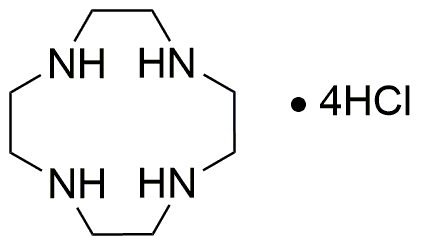1,4,7,10-Tetraazacyclododecane tetrahydrochloride is widely utilized in research focused on:
- Coordination Chemistry: This compound serves as a versatile ligand in coordination chemistry, forming stable complexes with various metal ions. This property is beneficial for researchers studying metal-organic frameworks or catalysis.
- Biomedical Applications: Its ability to form complexes with metal ions makes it useful in drug delivery systems, particularly for targeted therapies in cancer treatment, enhancing the efficacy of certain medications.
- Analytical Chemistry: It is employed in analytical methods to detect and quantify metal ions in environmental samples, providing a reliable approach for monitoring pollution levels.
- Material Science: The compound is used in the development of advanced materials, such as sensors and catalysts, due to its unique structural properties that enhance performance in various applications.
- Education and Training: It is often included in educational laboratories to teach students about ligand behavior and coordination complexes, providing hands-on experience in synthetic and analytical chemistry.
General Information
Properties
Safety and Regulations
Applications
1,4,7,10-Tetraazacyclododecane tetrahydrochloride is widely utilized in research focused on:
- Coordination Chemistry: This compound serves as a versatile ligand in coordination chemistry, forming stable complexes with various metal ions. This property is beneficial for researchers studying metal-organic frameworks or catalysis.
- Biomedical Applications: Its ability to form complexes with metal ions makes it useful in drug delivery systems, particularly for targeted therapies in cancer treatment, enhancing the efficacy of certain medications.
- Analytical Chemistry: It is employed in analytical methods to detect and quantify metal ions in environmental samples, providing a reliable approach for monitoring pollution levels.
- Material Science: The compound is used in the development of advanced materials, such as sensors and catalysts, due to its unique structural properties that enhance performance in various applications.
- Education and Training: It is often included in educational laboratories to teach students about ligand behavior and coordination complexes, providing hands-on experience in synthetic and analytical chemistry.
Documents
Safety Data Sheets (SDS)
The SDS provides comprehensive safety information on handling, storage, and disposal of the product.
Product Specification (PS)
The PS provides a comprehensive breakdown of the product’s properties, including chemical composition, physical state, purity, and storage requirements. It also details acceptable quality ranges and the product's intended applications.
Certificates of Analysis (COA)
Search for Certificates of Analysis (COA) by entering the products Lot Number. Lot and Batch Numbers can be found on a product’s label following the words ‘Lot’ or ‘Batch’.
*Catalog Number
*Lot Number
Certificates Of Origin (COO)
This COO confirms the country where the product was manufactured, and also details the materials and components used in it and whether it is derived from natural, synthetic, or other specific sources. This certificate may be required for customs, trade, and regulatory compliance.
*Catalog Number
*Lot Number
Safety Data Sheets (SDS)
The SDS provides comprehensive safety information on handling, storage, and disposal of the product.
DownloadProduct Specification (PS)
The PS provides a comprehensive breakdown of the product’s properties, including chemical composition, physical state, purity, and storage requirements. It also details acceptable quality ranges and the product's intended applications.
DownloadCertificates of Analysis (COA)
Search for Certificates of Analysis (COA) by entering the products Lot Number. Lot and Batch Numbers can be found on a product’s label following the words ‘Lot’ or ‘Batch’.
*Catalog Number
*Lot Number
Certificates Of Origin (COO)
This COO confirms the country where the product was manufactured, and also details the materials and components used in it and whether it is derived from natural, synthetic, or other specific sources. This certificate may be required for customs, trade, and regulatory compliance.


